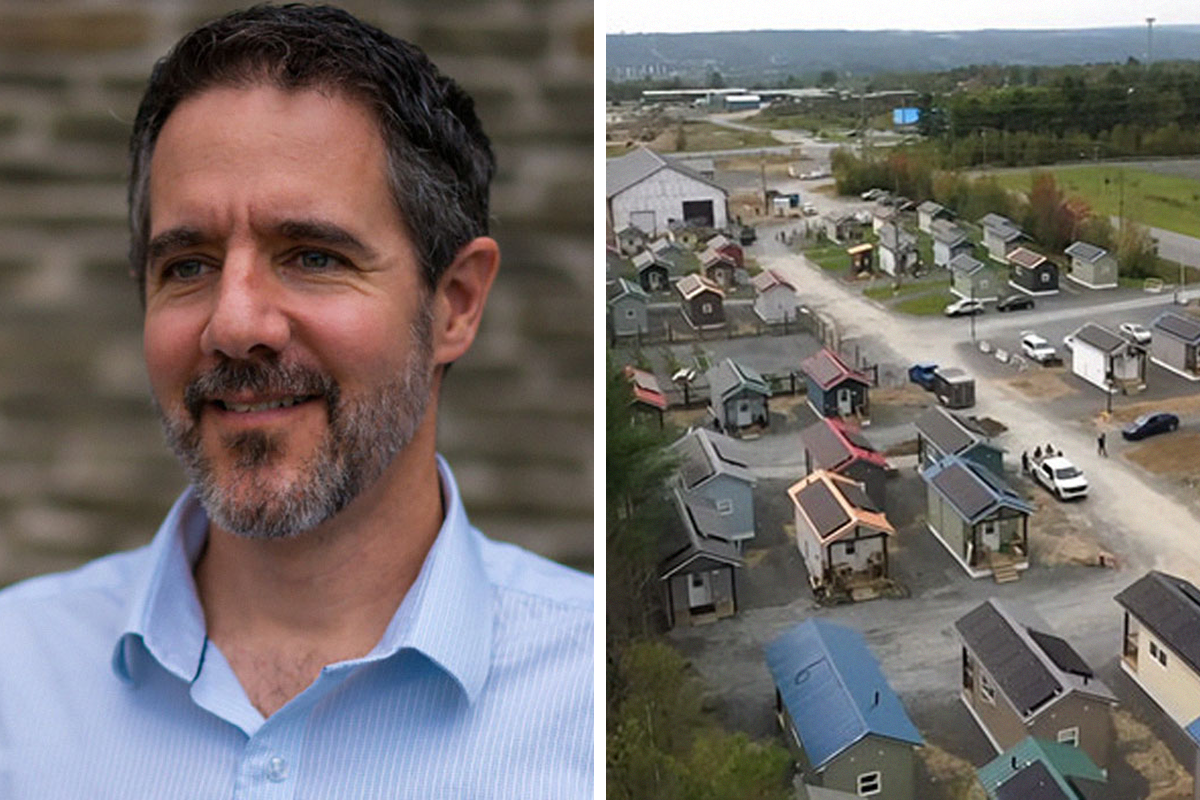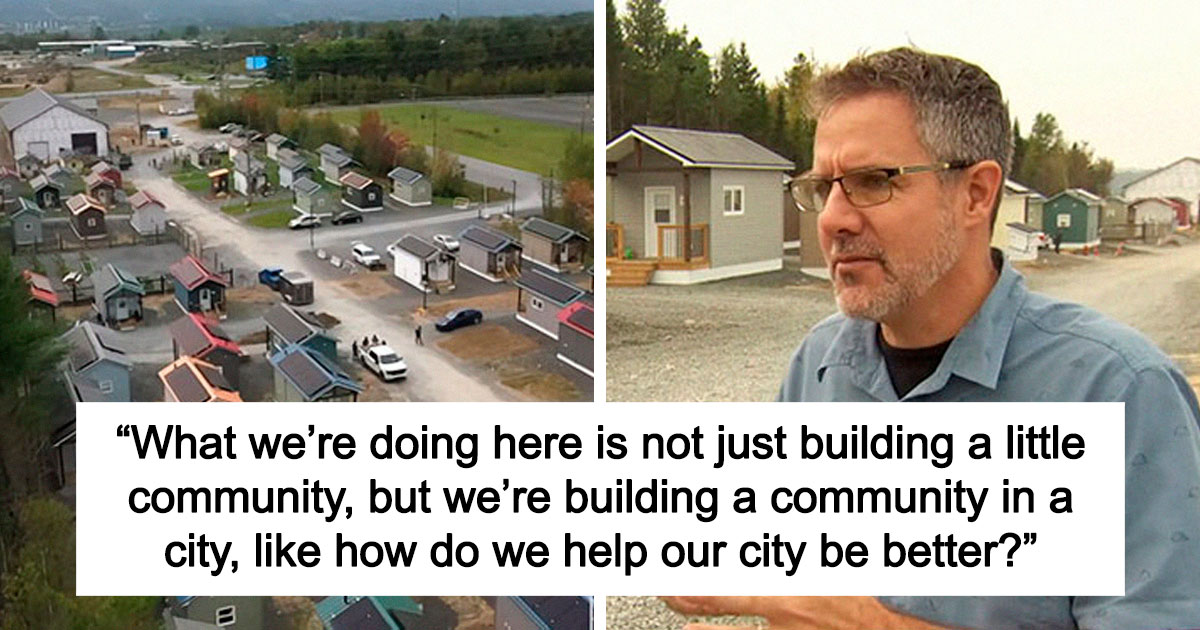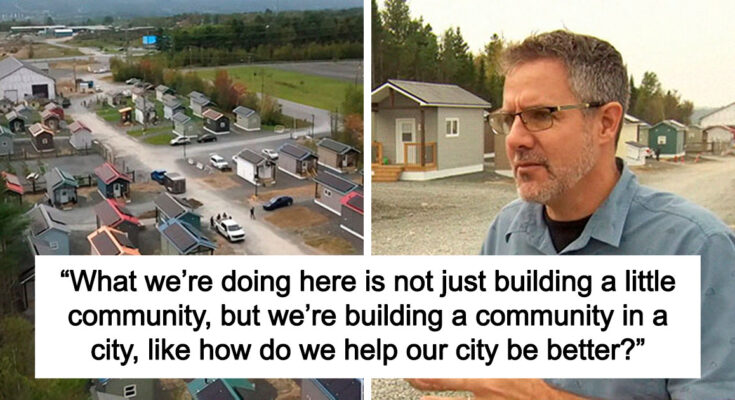Canadian Millionaire Builds 99 Tiny Houses to Combat Homelessness in His Community

Subheadline: A Visionary Philanthropist’s Bold Initiative Aims to Provide Hope and Stability for the Homeless
Main Article:
[Vancouver, British Columbia] – In a heartwarming display of philanthropy and community spirit, a Canadian millionaire has taken an extraordinary step in addressing homelessness in his local community by building 99 tiny houses. This bold initiative, driven by a deep sense of social responsibility, aims to provide safe and affordable housing for those most in need.
The man behind this inspiring project is Thomas Caldwell, a Vancouver-based entrepreneur who has made his fortune in the tech industry. Rather than indulging in the trappings of wealth, Caldwell has chosen to invest in the well-being of his community, focusing on one of the most pressing issues of our time: homelessness.
A Visionary Approach to Homelessness
Homelessness has been a persistent and growing challenge in many Canadian cities, particularly in Vancouver, where the high cost of living has exacerbated the issue. For Caldwell, the problem was not something to be ignored or left solely to government agencies. Instead, he saw it as an opportunity to make a tangible difference.
“I’ve been incredibly fortunate in my life and career,” Caldwell said in an interview. “But I’ve always believed that with great success comes great responsibility. Homelessness is not just a statistic—it’s a crisis affecting real people, and it’s up to all of us to do something about it. I wanted to create a solution that would provide more than just temporary relief; I wanted to offer a sense of stability and dignity to those who have been left behind.”
Caldwell’s solution was as innovative as it was compassionate: the creation of 99 tiny houses, each designed to offer a comfortable and secure living space for individuals and families currently without a home. These houses, though small in size, are big in impact—providing residents with the essentials they need to rebuild their lives.
The Tiny House Concept: Small Homes, Big Impact
The concept of tiny houses has gained popularity in recent years as a sustainable and affordable housing option. Typically ranging from 100 to 400 square feet, these homes are designed to maximize space efficiency while minimizing environmental impact. For Caldwell, the tiny house movement presented an ideal solution for addressing homelessness in a way that is both practical and scalable.
The 99 tiny houses built by Caldwell are part of a larger community development project located on a previously underutilized plot of land on the outskirts of Vancouver. Each house is equipped with basic amenities, including a kitchenette, bathroom, sleeping area, and small living space. The homes are constructed using eco-friendly materials and feature energy-efficient designs, ensuring that they are not only affordable but also sustainable.
Caldwell’s project is not just about providing shelter; it’s about creating a supportive community. The tiny house village includes shared facilities such as a communal kitchen, laundry area, and recreational spaces, fostering a sense of belonging among residents. Additionally, the village is staffed with social workers, counselors, and job placement experts to help residents transition back into society.
Building a Brighter Future: Caldwell’s Vision
For Caldwell, the tiny house project is just the beginning of his broader vision to combat homelessness. He hopes that the success of this initiative will inspire other wealthy individuals, businesses, and government agencies to take similar actions.
“I believe that homelessness is a solvable problem,” Caldwell explained. “It requires collaboration between the private sector, government, and the community. By providing stable housing, we can address many of the underlying issues that lead to homelessness, such as mental health challenges, unemployment, and addiction. But it starts with giving people a place to call home.”
Caldwell’s project has already garnered significant attention and praise from local officials, community leaders, and advocacy groups. Vancouver Mayor Kennedy Stewart lauded the initiative, calling it a “remarkable example of what can be achieved when people come together to address a common challenge.”
“This tiny house village represents hope,” Mayor Stewart said at the project’s unveiling. “It’s a testament to what’s possible when we prioritize compassion and creativity in our approach to social issues. I commend Thomas Caldwell for his leadership and commitment to making Vancouver a more inclusive city.”
A Community Transformed: Stories of Hope
The impact of Caldwell’s tiny house initiative is best understood through the stories of the people it has helped. For many residents, the opportunity to live in one of these houses has been life-changing.
Sarah Jenkins, a single mother of two who had been living in a shelter for over a year, is one of the first residents of the tiny house village. “This house has given me and my kids a chance to start over,” she said. “Before this, we were constantly moving from place to place, never knowing what the next day would bring. Now, we have a home—a place where my children can feel safe and secure. I can’t thank Mr. Caldwell enough for what he’s done.”
Similarly, John Turner, a former construction worker who lost his job and subsequently his home during the pandemic, expressed his gratitude for the project. “I’ve been through some tough times, but this tiny house has given me hope. It’s more than just a roof over my head—it’s a fresh start. I’m working with the counselors here to find a job and get back on my feet. I finally feel like I have a future again.”
Challenges and Criticisms: Addressing the Complexities of Homelessness
While Caldwell’s project has been widely praised, it has not been without its challenges and criticisms. Some skeptics argue that tiny houses, while helpful, are not a comprehensive solution to homelessness. They point out that addressing the root causes of homelessness—such as income inequality, lack of affordable housing, and systemic issues in mental health care—requires broader policy changes and long-term investment.
In response, Caldwell acknowledges that his project is not a panacea but rather a stepping stone toward a larger goal. “I’m under no illusion that tiny houses alone will solve homelessness,” he said. “But I do believe they can be part of a multi-faceted approach. We need to tackle this issue from all angles—housing, healthcare, education, and employment. My hope is that this project will inspire others to think creatively about how we can make a difference.”
A Call to Action: Inspiring Others to Join the Fight

Caldwell’s initiative has sparked a wave of interest in tiny house projects across Canada and beyond. Several other cities are now exploring similar approaches to address their own homelessness challenges. Caldwell himself has expressed a willingness to share his experience and expertise with others who are looking to replicate the model.
“I’m eager to collaborate with anyone who shares the same vision,” Caldwell said. “This is a crisis that affects us all, and it’s going to take all of us to solve it. I encourage other business leaders, philanthropists, and community members to step up and take action. Together, we can create a world where everyone has a place to call home.”
The Future of Housing: A New Model for Social Responsibility
As Caldwell’s tiny house village continues to grow, it serves as a beacon of hope and a model for what can be achieved when compassion meets innovation. The project has not only provided housing for nearly 100 people but has also reignited a conversation about the role of the private sector in addressing social issues.
Caldwell’s work has demonstrated that individuals with resources can play a crucial role in tackling societal challenges. By leveraging his wealth and influence, Caldwell has shown that it is possible to make a meaningful impact on the lives of those who need it most.
As the tiny house movement gains momentum, the lessons learned from Caldwell’s project could help shape the future of housing policy in Canada and around the world. The success of this initiative offers a blueprint for how communities can come together to address homelessness and create lasting change.
Conclusion: A Story of Compassion and Hope
Thomas Caldwell’s decision to build 99 tiny houses for the homeless is more than just a charitable act; it’s a powerful statement about what is possible when we prioritize the well-being of our neighbors. In a world where homelessness often seems like an intractable problem, Caldwell’s initiative shines a light on the potential for positive change.
Through his vision, determination, and generosity, Caldwell has provided a lifeline to those who have been struggling in the shadows. His tiny house village is a testament to the impact that one person can have when they choose to make a difference.
As more people hear about Caldwell’s work, there is hope that his example will inspire others to take action in their own communities. For those living in the tiny house village, the future is now a little brighter, thanks to the kindness of a man who refused to stand by and do nothing.



